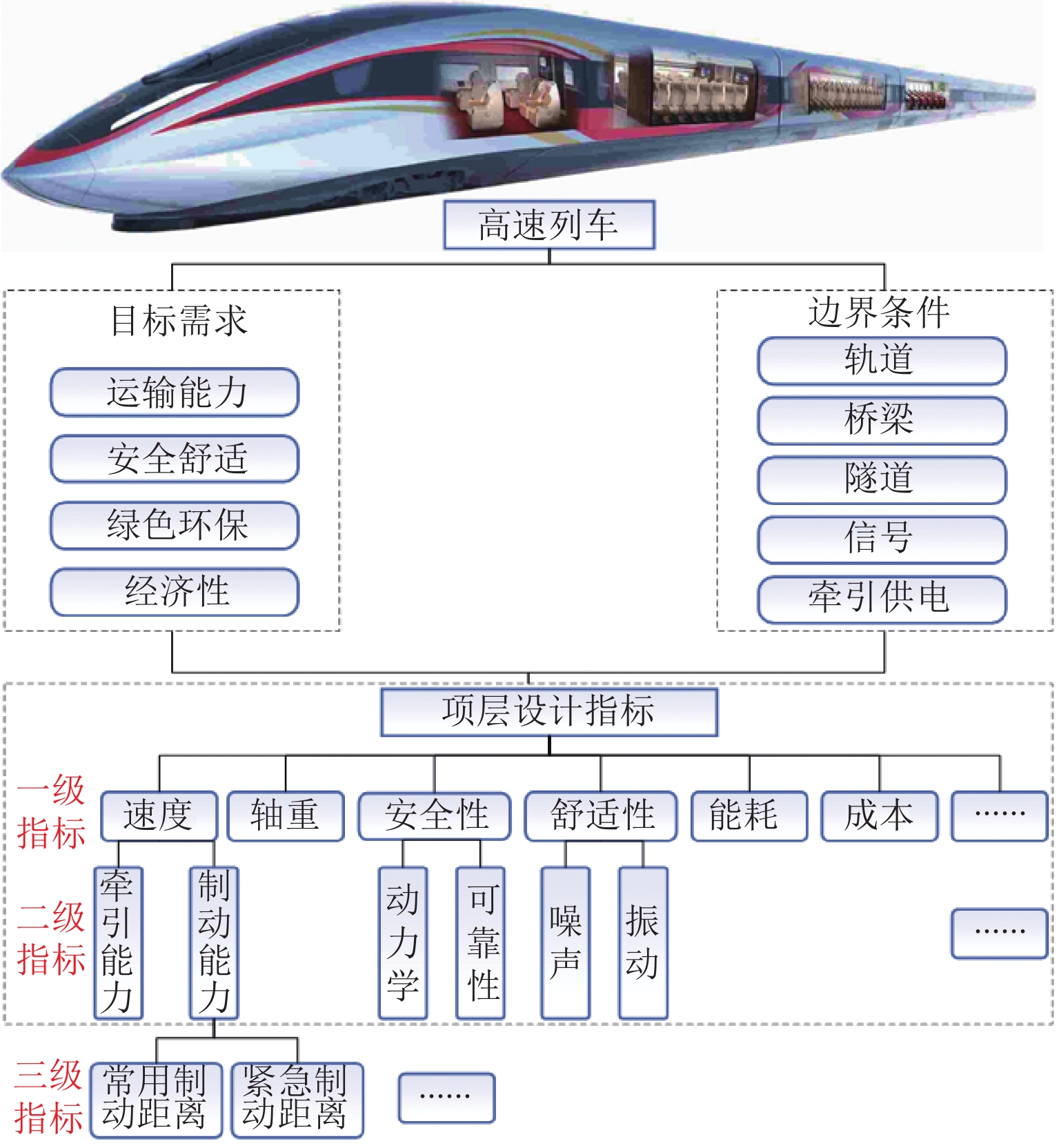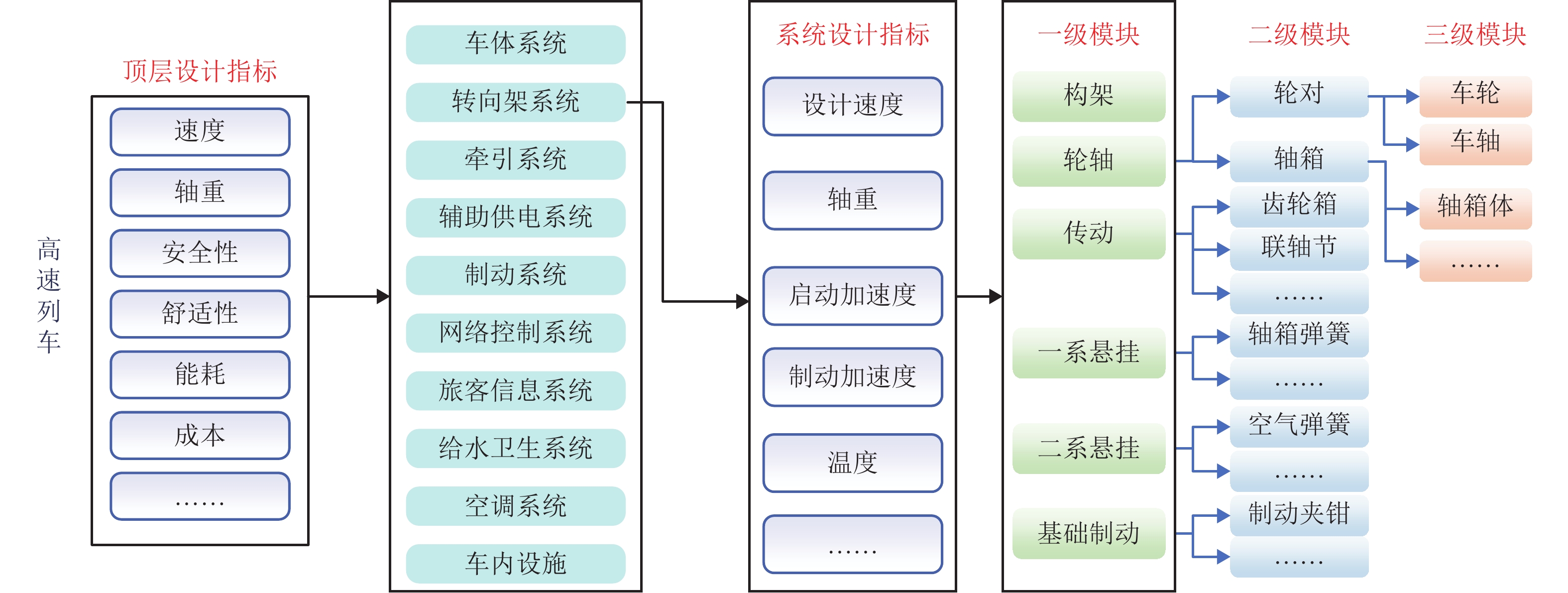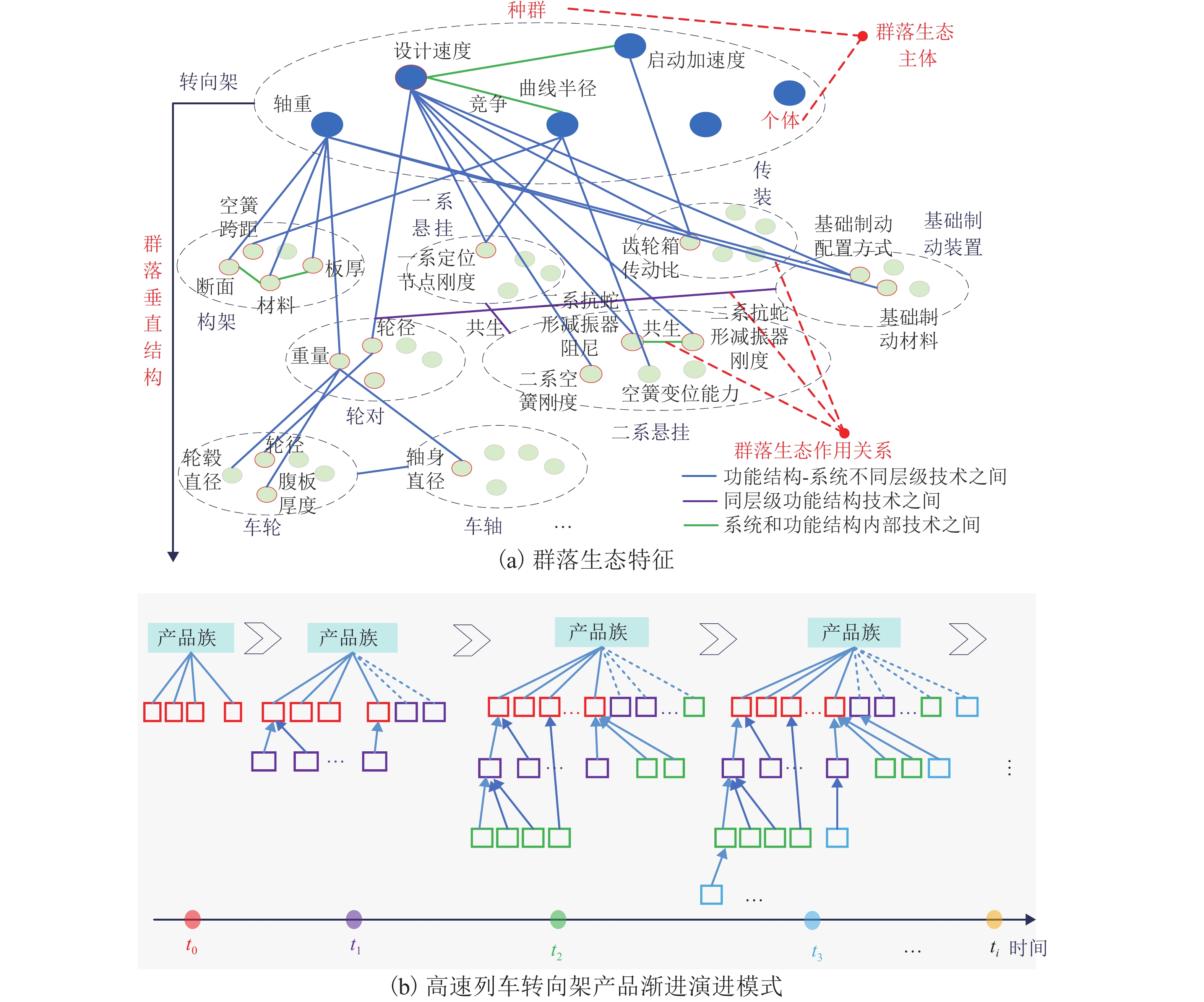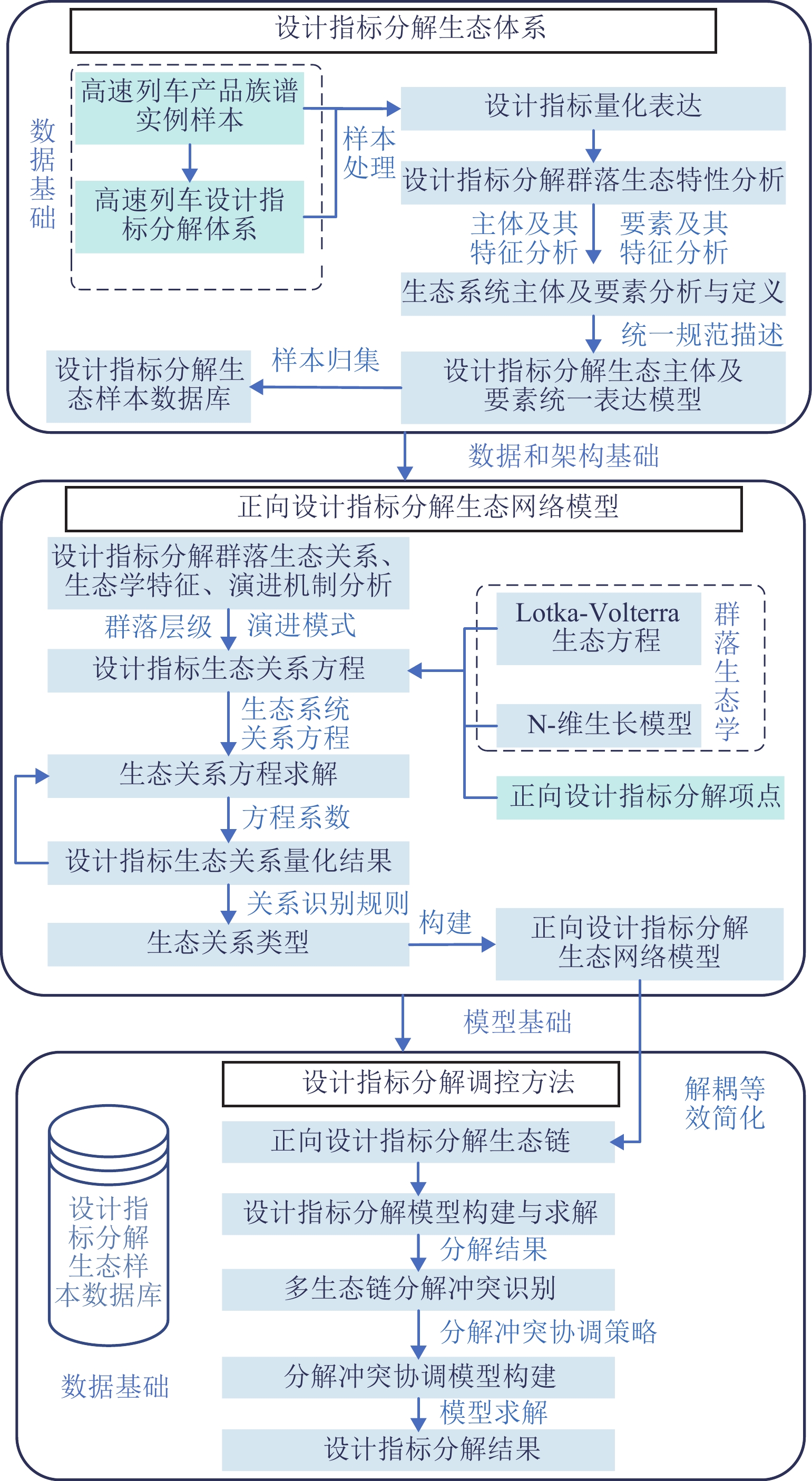Research Status and Prospect of Decomposition of Top-Level Design Indicators for High-Speed Trains
-
摘要:
顶层设计指标分解是决定高速列车正向设计周期长短和成功与否的首要环节. 首先,在阐述运输能力、安全舒适、绿色环保、经济性等高速列车顶层设计指标的基础上,从系统结构组成、运行边界条件以及大系统耦合作用等角度提出高速列车顶层设计指标分解所面临的技术挑战;然后,论述设计指标分解方法、设计指标分解关联模型和设计指标分解协调策略3个方面研究现状,并分析现有方法的不足与新需求;最后,展望群落生态学在高速列车顶层设计指标分解中的适用性,剖析基于群落生态学的高速列车顶层设计指标分解将会面临的关键问题,并给出相应的解决技术路线,以期为高速列车顶层设计指标分解的深入研究和实践提供参考.
Abstract:The decomposition of top-level design indicators is the primary link to determine the cycle length and success of forward design for high-speed trains. First, on the basis of expounding on the top-level design indicators of high-speed trains in terms of transportation capacity, safety and comfort, environmental protection, and economy, the decomposition challenges of top-level design indicators for high-speed trains were proposed from the perspectives of system structure, operating boundary conditions, and large-scale system coupling. Then, the research status was discussed, including the decomposition method, decomposition association model, and decomposition coordination strategy of design indicators, and the deficiencies and new needs of the existing methods were analyzed. Finally, the applicability of community ecology in the decomposition of top-level design indicators for high-speed trains was prospected. In addition, the key problems that will be faced by the decomposition of top-level design indicators for high-speed trains based on community ecology were analyzed, and corresponding technical routes for solutions were given, so as to provide a reference for the in-depth research and practice of the decomposition of top-level design indicators for high-speed trains.
-
Key words:
- high-speed train /
- design indicators /
- forward design /
- decomposition /
- community ecology
-
表 1 设计指标分解研究现状
Table 1. Research status of decomposition of design indicators
类别 方法名称 方法总结 设计指标分解方法 质量功能展开(QFD)[5]、公理化设计(AD)[6]、设计指标分解协调法[7]、目标逐层分解法(ATC)[8]、非合作博弈理论[20] 基于经验的解析方法和以优化为主的设计指标分解方法 设计指标关联建模 DEPNET解决方案[23]、层级交互随机子模型[24]、设计结构矩阵(DSM)[25]、设计结构网络(DSN)[27]、多源数据融合方法[28] 设计指标之间、设计变量之间、设计指标和设计变量之间、系统与组件之间依赖关系建模 设计指标分解协调策略 约束网络[30]、多目标决策[31]、线性加权和评价函数、希求水平、功用图[32]、可拓方法与TRIZ理论[34]、群体决策和TRIZ理论[37]、博弈理论[38] 多性能指标、多设计属性冲突建模与协调 -
[1] 张卫华,缪炳荣. 下一代高速列车关键技术的发展趋势与展望[J]. 机车电传动,2018(1): 1-5,12.ZHANG Weihua, MIAO Bingrong. Development trend and prospect of key technologies for next generation high speed trains[J]. Electric Drive for Locomotives, 2018(1): 1-5,12. [2] OSTERAS T, MURTHY D N P, RAUSAND M. Product performance and specification in new product development[J]. Journal of Engineering Design, 2006, 17(2): 177-192. [3] PAHL G A W B. Engineering design: a systematic approach[M]. Revised Edition. London: [s.n.], 1988 [4] 缪炳荣,张卫华,池茂儒,等. 下一代高速列车关键技术特征分析及展望[J]. 铁道学报,2019,41(3): 58-70.MIAO Bingrong, ZHANG Weihua, CHI Maoru, et al. Analysis and prospects of key technical features of next generation high speed trains[J]. Journal of the China Railway Society, 2019, 41(3): 58-70. [5] PEDERSEN S N, CHRISTENSEN M E, HOWARD T J. Robust design requirements specification: a quantitative method for requirements development using quality loss functions[J]. Journal of Engineering Design, 2016, 27(8): 544-567. doi: 10.1080/09544828.2016.1183163 [6] GE P, LU S C Y, SUH N P. An axiomatic approach for “target cascading” of parametric design of engineering systems[J]. CIRP Annals, 2002, 51(1): 111-114. doi: 10.1016/S0007-8506(07)61478-4 [7] 张科施,李为吉,魏宏艳. 设计指标最优分配的协同方法[J]. 机械科学与技术,2006,25(7): 797-801.ZHANG Keshi, LI Weiji, WEI Hongyan. A new method for collaborative allocation of design requirement optimum allocation[J]. Mechanical Science and Technology, 2006, 25(7): 797-801. [8] KIM H M, MICHELENA N F, PAPALAMBROS P Y, et al. Target cascading in optimal system design[J]. Journal of Mechanical Design, 2003, 125(3): 474-480. doi: 10.1115/1.1582501 [9] ZHANG H Z, QIN S F, LI R, et al. Progressive modelling of feature-centred product family development[J]. International Journal of Production Research, 2020, 58(12): 3701-3723. doi: 10.1080/00207543.2019.1634295 [10] BJÖRN A, SANDÉN. A framework for analysis of multi-mode interaction among technologies with examples from the history of alternative transport fuels in Sweden[J]. Research Policy, 2011, 40(3): 403-414. doi: 10.1016/j.respol.2010.12.005 [11] ZHANG G L, MORRIS E, ALLAIRE D, et al. Research opportunities and challenges in engineering system evolution[J]. Journal of Mechanical Design, 2020, 142(8): 081401.1-081401.14. [12] 张卫华. 高速列车顶层设计指标研究[J]. 铁道学报,2012,34(9): 15-19.ZHANG Weihua. Study on top-level design specifications of high-speed trains[J]. Journal of the China Railway Society, 2012, 34(9): 15-19. [13] QI Y H, ZHOU L. The Fuxing: the China standard EMU[J]. Engineering, 2020, 6(3): 53-66. [14] ZHAO H W, LIANG J Y, LIU C Q. High-speed EMUs: characteristics of technological development and trends[J]. Engineering, 2020, 6(3): 67-88. [15] 郑浩,冯毅雄,高一聪,等. 基于性能演化的复杂产品概念设计求解过程研究[J]. 机械工程学报,2018,54(9): 214-223.ZHENG Hao, FENG Yixiong, GAO Yicong, et al. The solving process of conceptual design for complex product based on performance evolution[J]. Journal of Mechanical Engineering, 2018, 54(9): 214-223. [16] 张根保,金传喜,冉琰,等. 基于FMA分解的关键质量特性映射变换技术[J]. 重庆大学学报,2019,42(3): 1-14.ZHANG Genbao, JIN Chuanxi, RAN Yan, et al. Mapping technique of key quality characteristics based on FMA decomposition[J]. Journal of Chongqing University, 2019, 42(3): 1-14. [17] KIM H, CHEN W, WIECEK M. Lagrangian coordination for enhancing the convergence of analytical target cascading[C]//11th AIAA/ISSMO Multidisciplinary Analysis and Optimization Conference. Portsmouth: AIAA, 2006, 44(10): 2197-2207. [18] 詹军,吕起越,伍家麟,等. 基于模型的整车操纵稳定性指标逐层分解方法研究[J]. 科学技术与工程,2016,16(14): 288-291.ZHAN Jun, LYU Qiyue, WU Jialin, et al. Study on target cascading of vehicle handling and stability index based on vehicle dynamics model[J]. Science Technology and Engineering, 2016, 16(14): 288-291. [19] 侯宇明. 商用车板簧建模及整车性能指标分解与综合关键技术研究[D]. 武汉: 华中科技大学, 2011. [20] YAZDANI S, LIN Y T, CAI W B, et al. A game theory perspective on requirement-based engineering design[M]//Disciplinary Convergence in Systems Engineering Research. Cham: Springer International Publishing, 2017: 901-910. [21] 张捷,姚丹,王瑞乾,等. 高速列车低噪声设计中的部件声学指标分解方法[J]. 交通运输工程学报,2021,21(3): 248-257.ZHANG Jie, YAO Dan, WANG Ruiqian, et al. Decomposition method to determine acoustic indexes of components in low-noise design procedure of high-speed trains[J]. Journal of Traffic and Transportation Engineering, 2021, 21(3): 248-257. [22] ZHANG H Z, HAN X, LI R, et al. A new conceptual design method to support rapid and effective mapping from product design specification to concept design[J]. The International Journal of Advanced Manufacturing Technology, 2016, 87(5): 2375-2389. [23] OUERTANI M Z, GZARA L. Tracking product specification dependencies in collaborative design for conflict management[J]. Computer-Aided Design, 2008, 40(7): 828-837. doi: 10.1016/j.cad.2007.07.002 [24] 邱曦伟. 大规模复杂IT系统可靠性、性能、能耗关联建模理论及其优化技术研究[D]. 成都: 电子科技大学, 2016. [25] 唐敦兵,彭义兵,刘政伟. 基于关联矩阵与设计结构矩阵的计算模型求解顺序规划[J]. 机械工程学报,2008,44(12): 173-179. doi: 10.3901/JME.2008.12.173TANG Dunbing, PENG Yibing, LIU Zhengwei. Execution sequence planning of computational models based on incidence matrix and design structure matrix[J]. Chinese Journal of Mechanical Engineering, 2008, 44(12): 173-179. doi: 10.3901/JME.2008.12.173 [26] TANG D, ZHU R, TANG J, et al. Product design knowledge management based on design structure matrix[J]. Advanced Engineering Informatics, 2010, 24(2): 159-166. doi: 10.1016/j.aei.2009.08.005 [27] LOUREIRO G B, FERREIRA J C E, MESSERSCHMIDT P H Z. Design structure network (DSN): a method to make explicit the product design specification process for mass customization[J]. Research in Engineering Design, 2020, 31(2): 197-220. doi: 10.1007/s00163-020-00331-y [28] 刘振宇. 超大型空分装备工艺-结构-能耗关联设计方法研究报告[J]. 科技创新导报,2016,13(10): 161. doi: 10.3969/j.issn.1674-098X.2016.16.090LIU Zhenyu. Process-structure-energy correlation design method for super-large air separation equipment[J]. Science and Technology Innovation Herald, 2016, 13(10): 161. doi: 10.3969/j.issn.1674-098X.2016.16.090 [29] 彭翔. 复杂产品设计中参数关联和等效简化方法及其应用[D]. 杭州: 浙江大学, 2014. [30] 张少彤,熊光楞,李涛. 基于参数协调模型的多学科协同设计方法[J]. 计算机学报,2004,27(1): 115-120.ZHANG Shaotong, XIONG Guangleng, LI Tao. Multidisciplinary design method based on parameter coordination model[J]. Chinese Journal of Computers, 2004, 27(1): 115-120. [31] 孟秀丽,易红,倪中华,等. 基于多目标决策的协同设计冲突消解方法研究[J]. 计算机集成制造系统,2005,11(5): 668-672. doi: 10.13196/j.cims.2005.05.26.mengxl.005MENG Xiuli, YI Hong, NI Zhonghua, et al. Research on conflict resolution method based on multi-objective decision-making in collaborative design[J]. Computer Integrated Manufacturing Systems, 2005, 11(5): 668-672. doi: 10.13196/j.cims.2005.05.26.mengxl.005 [32] 城取岳夫,刘阳春. 转向架设计的思考方法及新的尝试[J]. 国外铁道车辆,2008,45(4): 12-15.CHENGQU Yuefu, LIU Yangchun. The thinking method for design of bogies and new attempts[J]. Foreign Rolling Stock, 2008, 45(4): 12-15. [33] HOUSSIN R, COULIBALY A. An approach to solve contradiction problems for the safety integration in innovative design process[J]. Computers in Industry, 2011, 62(4): 398-406. doi: 10.1016/j.compind.2010.12.009 [34] ZHOU J, GUI F, ZHAO Y, et al. Model and application of product conflict problem with integrated TRIZ and Extenics for low-carbon design[J]. Procedia Computer Science, 2017, 122: 384-391. [35] GUI F Z, ZHOU J Q, ZHAO Y W, et al. Conflict coordination and its implementation probability of product low-carbon design[M]//Lecture Notes in Computer Science. Cham: Springer International Publishing, 2018: 184-191. [36] 洪欢欢,胡舜迪,赵鹏,等. 产品创新中技术冲突的粒度分类与可拓协调方法[J]. 计算机集成制造系统,2018,24(1): 136-145.HONG Huanhuan, HU Shundi, ZHAO Peng, et al. Granularity classification and extension coordination method for technology conflict in product innovation process[J]. Computer Integrated Manufacturing Systems, 2018, 24(1): 136-145. [37] SONG W Y. Service conflict identification and resolution for design of product-service offerings[J]. Computers & Industrial Engineering, 2016, 98: 91-101. [38] 孙丽琴. 基于互联空气悬架系统的车辆动态性能矛盾冲突分析与博弈控制[D]. 镇江: 江苏大学, 2018. [39] 丁国富,姜杰,张海柱,等. 我国高速列车数字化研发的进展及挑战[J]. 西南交通大学学报,2016,51(2): 251-263. doi: 10.3969/j.issn.0258-2724.2016.02.005DING Guofu, JIANG Jie, ZHANG Haizhu, et al. Development and challenge of digital design of high-speed trains in China[J]. Journal of Southwest Jiaotong University, 2016, 51(2): 251-263. doi: 10.3969/j.issn.0258-2724.2016.02.005 [40] 丁叁叁,陈大伟,刘加利. 中国高速列车研发与展望[J]. 力学学报,2021,53(1): 35-50.DING Sansan, CHEN Dawei, LIU Jiali. Research, development and prospect of China high-speed train[J]. Chinese Journal of Theoretical and Applied Mechanics, 2021, 53(1): 35-50. [41] 张卫华. 高速列车耦合大系统动力学理论与实践[M]. 北京: 科学出版社, 2013. [42] ODUM E P, BARRETT G W. Fundamentals of ecology[M]. 5th ed. Belmont: Thomson Brooks/Cole, 2005 [43] 张青田. 群落生态分析方法与应用[M]. 北京: 化学工业出版社, 2021. [44] VELLEND M. Conceptual synthesis in community ecology[J]. The Quarterly Review of Biology, 2010, 85(2): 183-206. doi: 10.1086/652373 [45] 朱云龙, 陈翰宁, 申海. 生物群智计算与机器学习[M]. 北京: 清华大学出版社, 2020. [46] ZHANG G, MCADAMS D A, SHANKAR V, et al. Modeling the evolution of system technology performance when component and system technology performances interact: Commensalism and amensalism[J]. Technological Forecasting and Social Change, 2017, 125: 116-124. doi: 10.1016/j.techfore.2017.08.004 [47] ZHANG G L, ALLAIRE D, MCADAMS D, et al. System evolution prediction and manipulation using a Lotka-Volterra ecosystem model[J]. Design Studies, 2019, 60: 103-138. doi: 10.1016/j.destud.2018.11.001 [48] NAIM A M, LEWIS K. Modeling the dynamics of innovation in engineered systems[C]//ASME 2017 International Design Engineering Technical Conferences and Computers and Information in Engineering Conference. Cleveland: [s.n.], 2017: 1-13. -





 下载:
下载:





